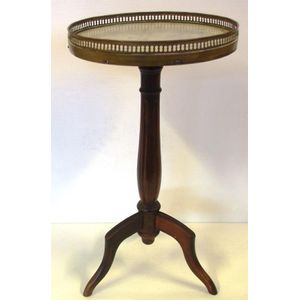Louis XVI Marble Top Occasional Table
A marble topped wine or occasional table, circa 1930s, with Louis XVI influence, the carrara marble circular top with a pierced, brass gallery raised on a fluted gently swollen stem to a tripod base, height 72 cm, diameter 32 cm
You must be a subscriber, and be logged in to view price and dealer details.
Subscribe Now to view actual auction price for this item
When you subscribe, you have the option of setting the currency in which to display prices to $Au, $US, $NZ or Stg.
This item has been sold, and the description, image and price are for reference purposes only.
- Carrara Marble - Carrara marble is a type of white or blue-grey marble quarried in the Carrara region of Tuscany, Italy. It is prized for its beauty, durability and the ease with which it can be worked. The marble has been used for thousands of years for sculptures and architectural details, and was particularly popular during the Renaissance period. Some of the most famous sculptures in the world, such as Michelangelo's David, were carved from Carrara marble. It is also widely used in the construction of buildings, floors, and countertops, both indoors and outdoors. This marble is known for its unique veining which gives it a distinctive look, and it's a popular choice for interior design, especially bathrooms and kitchens.
- Pierced Decoration - Ornamental woodwork with part of the background cut through and removed to produce an open-work pattern.
- Gallery - On furniture, a gallery is a small upright section, frequently pierced and decorated, around the tops of small items of furniture, such as davenports, side tables, and so forth. Galleries are made in brass or bronze,and be fretted, pierced or solid timber. A three-quarter gallery is one that surrounds three of the four sides of a table, desk or other top.
- Fluting - A form of decoration found on many pieces of furniture, as well as ceramics, silver and clocks, in which round-bottomed grooves, of varying width and depth, are let into columns, pilasters, legs. As a general rule, flutes are cut in the vertical, though they may follow a turned leg in a spiral pattern. In cross-section, they may be described as a series of 'U' shapes, rising and narrowing at each end of the groove. Fluting is the opposite of reeding, with which fluting is often associated.
- Circa - A Latin term meaning 'about', often used in the antique trade to give an approximate date for the piece, usually considered to be five years on either side of the circa year. Thus, circa 1900 means the piece was made about 1900, probably between 1895 and 1905. The expression is sometimes abbreviated to c.1900.
This item has been included into following indexes:
- tables, French - French, wine and ocasional 558
-
tables, purpose or type
- occasional 817
- wine 515
Visually similar items

Marble top pedestal wine or lamp table, height 54 cm approx
Sold by
in
for
You can display prices in $Au, $US, $NZ or Stg.

An English circular oak wine table, early 19th century. 70 cm high, 56 cm diameter
Sold by
in
for
You can display prices in $Au, $US, $NZ or Stg.

George III mahogany circular pie crust snap top supper table with bird cage action, on fluted tapering column with tripod legs
Sold by
in
for
You can display prices in $Au, $US, $NZ or Stg.

Victorian mahogany occasional table, with oval top, set on three splayed feet, height 70 cm
Sold by
in
for
You can display prices in $Au, $US, $NZ or Stg.
